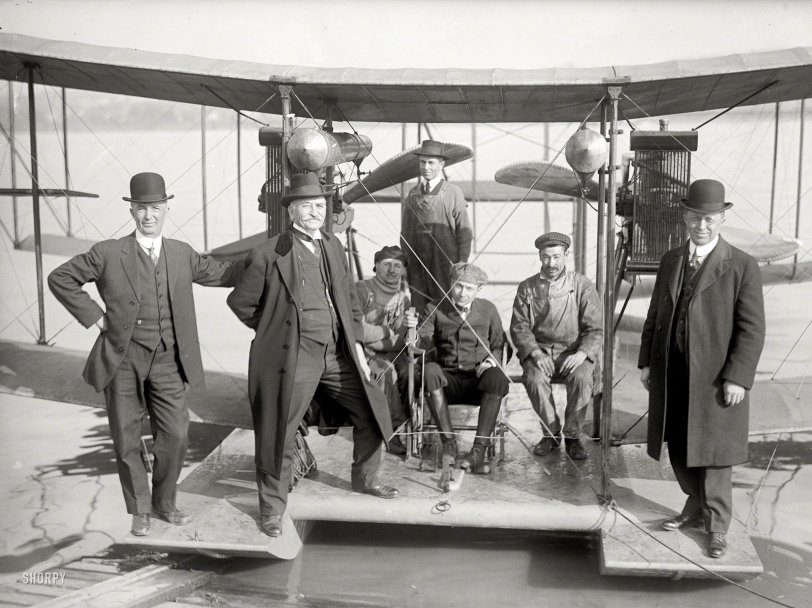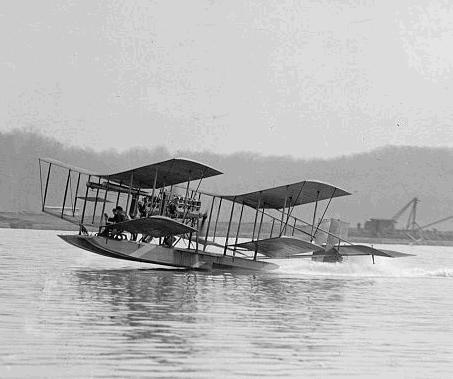


Framed or unframed, desk size to sofa size, printed by us in Arizona and Alabama since 2007. Explore now.
Shorpy is funded by you. Patreon contributors get an ad-free experience.
Learn more.

- Baldwin 62303
- Baldwin VO-1000
- Cold
- No expense spared
- Tough Guys
- Lost in Toyland
- And without gloves
- If I were a blindfolded time traveler
- Smoke Consumer Also Cooks
- Oh that stove!
- Possibly still there?
- What?!?
- $100 Reward
- Freeze Frame
- Texas Flyer wanted
- Just a Year Too Soon
- WWII -- Replacing men with women at the railroad crossing.
- Yes, Icing
- You kids drive me nuts!
- NOT An Easy Job
- I wonder
- Just add window boxes
- Icing Platform?
- Indiana Harbor Belt abides
- Freezing haze
- Corrections (for those who care)
- C&NW at Nelson
- Fallen Flags
- A dangerous job made worse
- Water Stop
Print Emporium
Family Plane: 1916

April 1916. Washington, D.C. "Richardson tandem biplane hydroplane on the Potomac. George A. Gray at controls. At left and right are Richardson brothers, who built the plane; 2nd from left is their uncle, whose idea it was." Harris & Ewing Collection glass negative. View full size.
And not a seatbelt in sight.
I do wonder when pilots figured out that they needed to be strapped in if they did not want to be sent plummeting to earth.
Note the aerodynamic fuel cells
I see they thought that one through! Then I see a faucet handle used as a fuel shut-off valve, and of course, the radiators are forward of it all. I wonder what the curb weight of the craft was?
Richardson Hydroaeroplane
Washington Post, May 3, 1914.Hull For Hydroplane
As a result of recent experiments conducted by a member of the advisory committee of the Langley aerodynamical laboratory of the Smithsonian Institution, a new form of flying boat hull has been evolved which appears to have decided advantages over the types now in use.
These experiments were made by Naval Constructor H.C. Richardson, U.S.N., chairman of the subcommittee on hydromechanics in relations to aeronautics of the Langley laboratory, at the model basin of the Washington navy yard. Several model hulls were used, some of which represented the different types of naval hulls now in use, one a model of the Curtiss pontoon, and others obtained through changes and improvements in standard forms. …
Washington Post, June 22, 1915.Hydroplane Tried Out.
Piloted by Dean R. Van Kirk, a Washington aviator, who is now engaged in an effort to organize an aeronautical reserve corps in the District of Columbia naval militia, the big Richardson hydroaeroplane launched here last week made two trial trips on the Potomac yesterday. In both instances minor defects, said by builders to be overcome easily, were discovered, but the plane demonstrated that it will attain high speed on the the water and the promoters expressed confidence in its ability to fly when the engines and all the parts are working smoothly.
Think
Of the courage it took and the faith they had in often untested theories to try and fly their aeroplanes. And look how far we've come.
Looking at George Gray
I believe he could fly any flying machine ever built, even today.
Unsung Heroes
Wonderful to see the three mechanics posing in this picture. So rarely seen, yet so very important to the development of early flight.
The flyboy in the middle
That's George Alphonso Gray, usually described as a "pioneer Wright aviator". He and his wife "Jack" were well-known barnstormers. Here's a link to their history (Excerpt: When George A. Gray took his lady-friend "Jack" Stearns for an aerial tour of Culpeper County in December 1912, in his 1910 Wright Model B airplane, several important and historic things happened. First, the people of Culpeper presented her with an engraved silver cup commemorating the event, and the governor of Virginia wrote her a letter of congratulations as "...the first woman from Virginia to fly from Virginia soil...." And within a year, Jack and George married.) And here's the Richardson taking off from the Potomac, Mr. Gray presumably doing the honors.

























On Shorpy:
Today’s Top 5